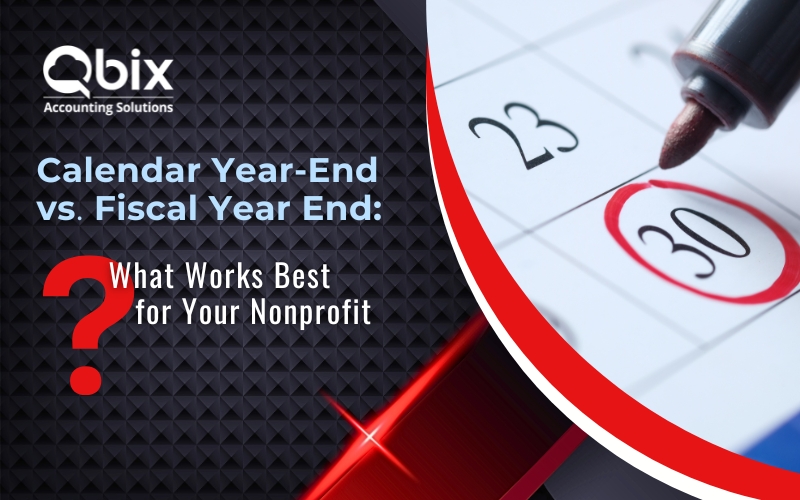Calendar Year-End vs. Fiscal Year-End – What Works Best for Your Nonprofit?
We already know that nonprofits are special. But when it comes to year-end, they’re even more so. Why? Because nonprofits are the only organizations that get to choose how to file their taxes — either by calendar year or their fiscal year. Of course, the timeframe for a standard calendar year is the same for all nonprofits, but a fiscal year can vary. If you’re trying to determine which is the best for your nonprofit, read on. Here, you’ll learn the definitions, as well as the advantages and disadvantages of each, along with the primary considerations to keep in mind. If you decide to change your fiscal year, we’ve outlined how and when to do that, too.

What is a calendar year-end?
A calendar year-end is a 12-month accounting period that begins on January 1 and ends on December 31. It is the most common fiscal year-end for nonprofits in the United States.
What are the advantages of a calendar year-end?
A calendar year-end is characterized by its simplicity, aligning with most individuals’ and businesses’ tax years. It offers consistency, facilitating easy comparisons and tracking over time. Moreover, it’s transparent and straightforward for donors and stakeholders.
What are the disadvantages of a calendar year-end?
A calendar year-end may not align with nonprofit organizations’ funding cycles or program timelines, making budgeting and reporting more challenging. In addition, changing the fiscal year-end can be a complex and time-consuming process, necessitating approval from the organization’s board and filing with the IRS.
What is a fiscal year-end?
A fiscal year-end is a 12-month accounting period that begins and ends on any date other than December 31. Nonprofits can choose any fiscal year-end that works best for them — one of the most common being June 30.
What are the advantages of a fiscal year-end?
A fiscal year-end is a flexible choice, allowing nonprofits to synchronize it with their funding and program cycles. This alignment simplifies budgeting and performance tracking. Importantly, changing the fiscal year-end is generally easier for nonprofits, as it doesn’t require IRS approval.
What are the disadvantages of a fiscal year-end?
A fiscal year-end may appear less straightforward and transparent to stakeholders unfamiliar with this concept. It also lacks the consistency of calendar year-ends, making comparing financial performance with other nonprofits more challenging.
Considerations to keep in mind when choosing or changing a fiscal year for your nonprofit:
- Program year – Your organization’s fiscal year should match its program year to avoid splitting program activities across two fiscal years. For instance, if most of your programs occur in summer, June 30 is probably not the best fiscal year-end for your nonprofit.
- Revenue streams – Nonprofits often receive a substantial portion of their revenue from donations, especially during the fourth quarter of the calendar year. Generosity, traditions, and tax benefits drive that increase. But it also makes a calendar year-end more challenging since it’s hard to promptly account for the increased revenue, which could negatively impact net income.
- Grant cycles – Aligning the fiscal year-end with major grants and funders’ terms can streamline grant reporting and simplify the process for your organization.
- Audit evidence – Organizations that require an audit will need extra time to not only close the books but also to assemble audit evidence before closing their year. If the audit occurs during the organization’s busiest time of year, it could hamper gathering all the proper audit evidence.
- Debt covenants – When selecting a year-end, organizations with substantial debt covenants should factor in the cyclical nature of their operations and their effect on covenant calculations.
- State charitable registrations – Many states require that charitable groups register —a process that usually requires financial statements including a Form 990, a copy of tax-exempt status from the IRS, and a formal audit report. Opting for a calendar year simplifies this paperwork, but changing the selection of the tax year complicates the process.
How to change your nonprofit’s year-end
If you decide you want to change your organization’s fiscal year, you must inform the IRS. A Form 1128, “Application to Adopt, Change, or Retain a Tax Year,” must be filed along with Form 990 for the short period that bridges the gap between your original year-end and your new year-end. You must submit a copy of your nonprofit’s tax-exempt ruling letter from the IRS with Form 1128. Be sure to write “Change in Accounting Period” in big, bold letters on the top of the Form 990 that you file after the accounting period change. If you require an extension for filing the short-period Form 990, you must file that before the initial due date of the new fiscal year.
When to change your nonprofit’s year-end
To change your fiscal year, your Form 1128 must be filed by the due date (not including extensions) of the tax return for the first effective year. The earliest it may be filed is the day following the end of the first effective year. Your Form 990 must be filed by the 15th day of the 5th month after the close of the new fiscal year. For example, an organization utilizing the typical calendar year would file by May 15 of the following year. If your nonprofit ends its tax cycle in June, the deadline is November 15.
If you’re feeling a bit unsure about choosing your fiscal year or how or when to change it, don’t hesitate to reach out to our friendly experts at Qbix. Our dedicated accounting team helps hundreds of nonprofits like yours, and we’d be thrilled to help yours too. Don’t wait to get the laborsaving, insightful guidance you need. Schedule your free-of-charge consultation today.
Non Profit Accounting Solutions
About Us
Qbix's goal is to provide the latest cloud-based accounting technology while delivering real-time visibility into your nonprofit's financials 24/7. Numbers are our passion, but providing your nonprofit with the financial expertise needed to facilitate growth and profitability is our top priority. And because no two organizations are the same, Qbix offers the flexibility you need to accomplish your nonprofit's goals.
Qbix
500A Northside Crossing
Macon, GA 31210
(478) 787-0532
Let Us Prepare Your Form 990
Save time, money, and stress. Let us prepare your Form 990. Schedule a consultation today.






